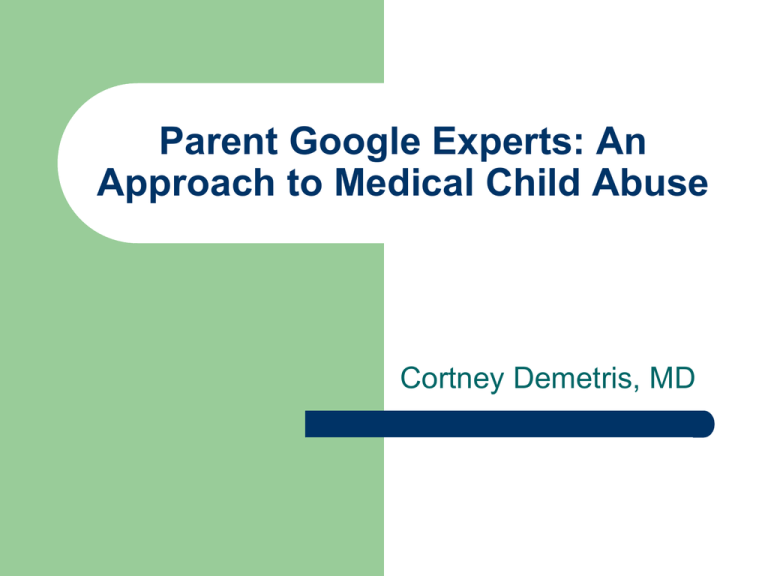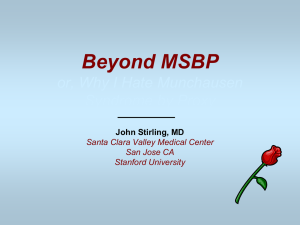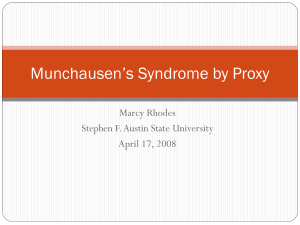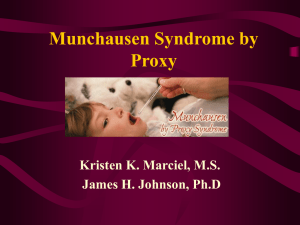Child Abuse in the Medical Setting
advertisement

Parent Google Experts: An Approach to Medical Child Abuse Cortney Demetris, MD Objectives Define Medical Child Abuse (MCA) Know why the term Munchhausen Syndrome by Proxy is no longer preferred Differentiate Vulnerable Child Syndrome from MCA Differentiate Simulators from Producers Understand the importance of documenting objectively in all cases of suspected child abuse Understand the benefits and limitations of covert video surveillance Know the risk in siblings of affected victims of MCA What’s in a name? Munchausen Syndrome by Proxy (MSBP) Factitious Disorder by Proxy (FDBP) Pediatric Condition Falsification (PCF) Child Abuse in the Medical Setting Medical Child Abuse Situation specific descriptive terms Munchausen Syndrome by Proxy Initially described by Sir Roy Meadow as a case report published in the Lancet in 1977 Defined as “parents who, by falsification, caused their children innumerable harmful hospital procedures – a sort of Munchausen syndrome by proxy.” Active debates regarding the use of this term Remains the most commonly used and most easily recognized term for this type of child abuse Factitious Disorder by Proxy Initially described in 1994 in the Diagnostic and Statistical Manual of Mental Disorders (DSM-IV) Used to describe the perpetrator of the child abuse and diagnosed by a psychiatrist or psychologist Defined as “intentional production or feigning of physical or psychological signs or symptoms in another person who is under the individual’s care” Can only be used if the motivation is determined to be related to attention received as the sick role by proxy Pediatric Condition Falsification Described in 2002 by the American Professional Society on the Abuse of Children (APSAC) Used to described the abused child and diagnosed by pediatric care providers caring for the child May be diagnosed in the abused child in the absence of a diagnosis in the perpetrator of FDBP APSAC describe the term MSBP in cases where the child is diagnosed with PCF and the perpetrator is diagnosed with FDBP Child Abuse in the Medical Setting Described in 2007 by the AAP Committee on Child Abuse and Neglect Also called Medical Child Abuse, especially in the recent British literature Described as distinct from other forms of child maltreatment because of “the involvement of the medical treatment community in the abuse process.” Situation Specific Descriptive Terms Advocated for as a way to solve the current debate surrounding terminology Example: 6 m/o repeatedly presents with seizures that are witnessed only by the mother and eventually determined to be falsified by the mother. The child is diagnosed with: – – Maternal falsification of seizure disorder Child abuse Definitions Defining Medical Child Abuse Current AAP terminology: vulnerable child syndrome, illness exaggeration, illness fabrication, and illness induction Commonly used terms – simulator versus producer Medical Child Abuse Defined Illness is persistently and secretly, simulated and/or produced, by a parent or in loco parentis; and repeatedly presented for medical assessment and care Results in multiple medical procedures both diagnostic and therapeutic Acute signs / symptoms of illness stop when the perpetrator and the child are separated Specifically excludes: – – – physical abuse only sexual abuse only non-organic failure to thrive that is solely the result of nutritional / emotional deprivation Vulnerable Child Syndrome Initially described in 1964 by Dr. Green Described as a physically healthy child who is viewed by his parents as being at greater risk for behavioral, developmental, or medical problems Most of the children were previously critically ill or perceived by their parents are having a “close call” medical event and most “outgrow” the diagnosis following the pre-school years. Parents present for medical care early and often in the course of a minor childhood illness and often overindulge the child, have trouble setting limits, tolerate physical abuse towards the parent, and have difficulty with separation from the child Levy (1980) interviewed 750 parents and found 27% of them felt that their child was unusually vulnerable to illness. Review of medical records revealed that there was not any medical basis for this belief in 40% of the cases. Illness Exaggeration Exaggerates actual symptoms Exaggerates actual past medical history Examples: – – Child has a mild cough for 1 day and parent reports coughing “non-stop” for a month, can’t get any sleep, posttussive emesis, and respiratory distress Child with 2 episodes of non-bloody non-bilious emesis and parent reports 25 episodes of emesis some with blood in them Illness Fabrication Reports non-existent symptoms Fabricates medical tests Examples: – – – – – Reports school is sending the child home for emesis at school everyday for a month; school reports no emesis ever and a near perfect attendance record Puts eggs in a urine specimen to make it positive for protein Puts menstrual blood in a child’s diaper to cause the appearance of bloody stools Puts the thermometer under hot water when the nurse steps out of the room Grossly under reports oral intake on a calorie count Illness Induction Does something to the child to cause the symptoms to be present Examples: – – – – Smothers a baby to the point of apnea Gives the child ipecac to induce vomiting Give the child oral hypoglycemic medications to cause low blood sugars Poisons the child with rat poison to cause excessive bleeding Simulators versus Producers Simulators – – Producers – Illness exaggeration Illness fabrication Illness Inducers In Rosenberg’s literature review of MSBP (1987) he reports – – – 25% simulators only 25% producers only 50% simulators and producers Case Presentation - Benjamin 4 m/o male with multiple complaints including – – – – – Emesis Seizures Raspy breathing Coughing Feeding problems Large previous w/u mostly negative Case Presentation - Benjamin Patient placed on a Video EEG ST and OT to work on a feeding plan Home medications continued Patient observed by hospital staff to be healthy Mother reporting multiple significant problems; none of which are observed when video EEG is reviewed Mother reporting to her family members that patient is deaf, was admitted with a bad pneumonia, has such bad seizures he may never recover, and “I can’t stand looking at him looking so sick”. Work-up - Benjamin Extensive history Complete medical record review Watch video component of the video EEG Medical Record Review 4 different hospitals 2 pediatricians 4 pediatric subspecialty physicians many ancillary services totaling 32 medical visits in his 4 months of life Medical Record Review - Studies Pyloric Ultrasound on 5/5/08 Chest X-ray on 5/5/08 Basic Metabolic Panel on 5/6/08 Pyloric Ultrasound on 5/6/08 Upper GI on 5/6/08 Abdominal X-ray on 5/7/08 Complete Blood Count with Differential on 5/21/08 Basic Metabolic Panel on 5/21/08 Blood Culture on 5/21/08 Catheterized Urine Culture on 5/21/08 Spinal Tap on 5/21/08 Pyloric Ultrasound on 5/21/08 Upper GI on 5/22/08 Chest X-ray on 5/31/08 Basic Metabolic Panel on 5/31/08 Pyloric Ultrasound on 5/31/08 Abdominal X-ray on 5/31/08 Skeletal Survey on 5/31/08 Medical Record Review - Studies Head CT scan without contrast on 5/31/08 Auditory Brainstem Evoked Response (hearing test) on 6/2/08 Complete Blood Count with differential on 6/14/08 Comprehensive Metabolic Panel on 6/14/08 Coagulation studies on 6/14/08 Catheterized Urine Analysis on 6/14/08 Catheterized Urine culture on 6/14/08 Blood Culture on 6/14/08 Abdominal and Chest X-ray on 6/14/08 Pyloric Ultrasound on 6/14/08 Stool culture on 6/14/08 Stool for ova and parasites on 6/14/08 Head CT scan without contrast on 6/15/08 EGD and Colonoscopy were performed at The Surgery Center of Carmel on 6/25/08 Basic Metabolic Panel on 6/19/08 Medical Record Review - Studies Blood culture on 6/19/08 Catheterized Urine Analysis on 6/19/08 Catheterized Urine Culture on 6/19/08 Abdomen X-Ray on 6/19/08 Chest X-ray on 6/19/08 Abdominal X-ray on 7/3/08 Stool Hemoccult three times on 7/3/08 Gastric Emptying Scan on 7/22/08 Barium Swallow Study on 7/22/08 EEG on 8/22/08 Brain MRI without contrast on 8/18/08 Lactic Acid on 8/18/08 Acylcarnitines, plasma on 8/18/08 Carnitine on 8/18/08 Portable 48 hour EEG on 8/27/08 Video EEG on 8/28/08 Auditory Brainstem Evoked Response (hearing test) on 9/5/08 Diagnosis - Benjamin “I have had the opportunity to complete an extensive medical history given by Benjamin’s mother; conduct a thorough physical examination on Benjamin; carefully review medical records from 4 different hospitals, 2 pediatricians and 4 pediatric subspecialty physicians as well as ancillary services totaling 32 medical visits; spend many hours reviewing the video associated with Benjamin’s Video EEG; and to review documentation by nurses, physicians, and various ancillary staff members during Benjamin’s current hospital stay.” Diagnosis - Benjamin “After this complete review of all the above mentioned information it is clear to me that Benjamin is suffering from child abuse in the form of Medical Child Abuse (formerly called Munchausen Syndrome by Proxy). Medical child abuse is a form of child abuse in which the child suffers at the hands of health care providers who have been given an inaccurate medical history by a caregiver leading to many unnecessary medical interventions.” Case Presentation - Joshua 15 m/o male with ALTE Healthy until first presentation of ALTE at 12 m/o Large previous w/u mostly negative Mother of child not asking for procedures or testing; does not appear medically sophisticated; not “typical” of perpetrators of this form of child abuse Case Presentation - Joshua Admitted Neurology, Pulmonology, and CPT consulted Plan to place on Video EEG Prior to CPT consultation patient with episode of desats to the 50’s on monitor Video EEG urgently arranged Medical Record Review – Joshua Presented on 6/25 with first ALTE at 12 m/o Presented on 7/29 with second ALTE and large w/u negative for etiology at that time Presented on 8/28 with the third ALTE and much of the first w/u is repeated and still negative; diagnosis is breath holding spells Presented on 9/27 with the forth ALTE Medical Record Review - Joshua Echo: nml EKG: sinus tach Swallow Eval: nml EEG x 3: nml Video EEG x 2: nml MRI Brain: 8mm cyst; white matter volume loss Sleep Study x 2: nml CBC x 4: nml BMP x 2: low bicarb (19&20) CMP x 2: low bicarb on 1 CXR x 3: nml aside from RML atelectasis on 2 Cardiology consult Neurology consult Video EEG - Joshua Diagnosis - Joshua During my review of the Video EEG I saw D*** choke Joshua on at least 9 occasions and there were two other occasions that seem most consistent with relatively brief choking episodes. It is my medical opinion that Joshua is in serious and immediate danger of death in the care of D*** and that he is clearly the victim of child abuse. Epidemiology - Victims Incidence of MSBP, non-accidental suffocation, and non-accidental poisoning in the UK were reported as – – 2.8/100,000 in infants less than 1 y/o 0.4/100,000 in children less than 16 y/o Most victims are less than 5 y/o, in one study the mean age at diagnosis was 15-22 months old. Children of both genders are victims equally as frequently. Epidemiology - Perpetrators Perpetrator is usually the mother, reported in 9499% of the cases Men reported the primary perpetrator in 5-7% of cases One study reported that 80% of the perpetrators worked in healthcare facilities or daycare facilities Studies looking at perpetrators have found many different types of psychiatric diagnosis including personality disorders, primary factitious disorder, depression, and rarely psychosis; no pattern has emerged Epidemiology - Siblings Siblings are at increased risk – – In one study, of the families in which the index case had at least one sibling; 40% had a history of abuse in a sibling and 18% had a history of sibling death In one meta-analysis (Sheridan, 2003) of 451 MSBP victims, of 210 known siblings; 61% had symptoms similar to that of the victim and 25% were dead Birth order differences in victimization are not present Clinical Presentations Any are possible in Medical Child Abuse Most common clinical presentation is apnea Also reported commonly are seizures, bleeding, vomiting, diarrhea, altered mental status, fever, and rash Often the symptoms or the course of the disease do not make sense from a scientific medical perspective Children with an underlying medical diagnosis can be victims if the caregiver demands excessive and unnecessary medical care Evaluation – What do to Obtain and review the medical record for evidence of a diagnosis, including, but certainly not limited to Medical Child Abuse Remember that there will be cases in which a full review of the medical record reveals an unusual diagnosis or does not support child abuse as a diagnosis The importance of documenting objectively the observance of unusual symptoms in a child that are perceived and reported by a caregiver cannot be overemphasized. Care conference involving several care providers across disciplines can be very helpful in making a diagnosis and creating / securing cooperation with a treatment plan Evaluation - What not to do The motivation of the perpetrator / caregiver should not be considered in making the diagnosis of child abuse in the child victim Know that characteristics of the abuser, such as those list below, are not sensitive or specific indicators of MSBP and should not be relied upon to make the diagnosis – – – being female working in the medical setting having a disengaged spouse Evaluation – Covert Video Surveillance Pros – – – Evidence of a diagnosis Child is protected from perpetrator Perpetrator can get psychological treatment for their disorder Cons – – – 4th amendment right to privacy Violation of trust in a physician / parent relationship Need to monitor the video continuously by staff with a plan to intervene for the safety of the child, if needed United Kingdom Experience 39 cases suspected of MSBP as the cause of ALTE seen 1986-1994 at 2 locations already equipped with CVS Compared (“controlled”) to 46 children seen in the same time frame with ALTE requiring CPR and were later determined to have ALTE caused by a underlying physiological malfunction CVS revealed abuse in 85% of the suspected cases and included suffocation (30 cases), deliberate fracture (1 case), and poisoning (2 cases) MSBP versus “Controls” First ALTE at median age of 3.6 months CGA 3 (8%) born prematurely Bleeding from nose and/or mouth seen in 11 cases (29%) First ALTE at median age of 0.3 months CGA 27 (59%) born prematurely Bleeding from the nose and/or mouth seen in 0 cases Children’s Health Care of Atlanta’s Experience Established a CVS program in pediatrics for the sole purpose of evaluation of MSBP Reported on 41 cases seen in 1993-1997 Made a “certain” diagnosis of MSBP in 23 of the cases – – – 2 were inducers only 11 were inducers and fabricators 10 were fabricators only CVS was found to be – – – required to make the diagnosis of MSBP in 56% of the cases supportive of the diagnosis of MSBP in 22% of the cases supportive of non-child abuse diagnosis in 10% of the cases Management Goals Make sure the child is safe Make sure the child’s future safety is also assured Allow treatment to occur in the least restrictive environment Management Having a multidisciplinary case conference involving DCS in many cases, is invaluable in achieving a consensus and developing a treatment plan for on-going medical care that assures the safety of the child Should also consider siblings safety Outcomes By definition 100% of the victims have some shortterm morbidity as a result of their abuse, from the unnecessary medical testing / treatments. Long-term morbidity is reported as 8% in one study. Mortality rates are reported between 6-10% in general MSBP cases; however were as high as 33% in a series looking at suffocation and poisoning cases only. Summary Always include Medical Child Abuse on the differential of unusual medical presentations Remember that Medical Child Abuse is not a diagnosis of exclusion and can be worked-up along side other plausible diagnoses on the differential Forget about your preconceived notions regarding “google experts” and focus on the nature of the presenting symptoms. Questions? References Reece RM and Ludwig S. Child Abuse: Medical Diagnosis and Management 2nd Edition. 2001 by Lippincot Williams and Wilkins. Stirling J and the Committee on Child Abuse and Neglect. Beyond Munchausen Syndrome by Proxy: Identification and Treatment of Child Abuse in a Medical Setting. Pediatrics 2007; 119:102-1030. Hettler J. CME Review Article: Munchausen Syndrome by Proxy. Pediatric Emergency Care 2002; 18(5):371-374. Galvin HK, Newton AW, Vandeven AM. Update on Munchausen Syndrome by Proxy. Current Opinion in Pediatrics 2005; 17:252-257. Morrison CA. Cameras in Hospital Rooms: The Fourth Amendment to the Constitution and Munchausen Syndrome by Proxy. Critical Care Nursing Quarterly 1999; 22(1):65-68. Donald T and Jureidini J. Munchausen Syndrome by Proxy: Child Abuse in the Medical System. Archives of Pediatrics and Adolescent Medicine 1996; 150(7):753-758. Mart, EG. Factitious Disorder by Proxy: A Call for the Abandonment of an Outmoded Diagnosis. The Journal of Psychiatry and Law 2004; 32:297-314 Southall DP and Plunkett, MCB. Covert Video Recordings of Life Threatening Child Abuse: Lessons for Child Protection. Pediatrics 1997; 100(5):265-82, References continued Craft AW and Hall DBM. Munchhausen Syndrome by Proxy and Sudden Infant Death. British Medical Journal 2004; 328:1309-1312 Parrish M and Perman J. Munchausen Syndrome by Proxy: Some Practice Implications for Social Workers. Child and Adolescent Social Work Journal 2004; 21(2):137-154. Meadow R. What is, and What is not, ‘Munchausen Syndrome by Proxy’? Archives of Disease in Childhood 1995; 72:534-538. Fisher GC and Mitchell I. Is Munchausen Syndrome by Proxy really a Syndrome? Archives of Disease in Childhood 1995; 72:530-534. Green, M. Vulnerable Child Syndrome and Its Variants. Pediatrics in Review 1986; 8:75-80. Hall DE, Eubanks L, Swarnalatha M, Kenney RD, Johnson SC. Evaluation of Covert Video Surveillance in the Diagnosis of Munchausen Syndrome by Proxy: Lessons From 41 Cases. Pediatrics 2000; 105(6):1305-1312. Pearson SR and Boyce WT. Consultation with the Specialist: The Vulnerable Child Syndrome. Pediatrics in Review. 2004;25:345-349.









